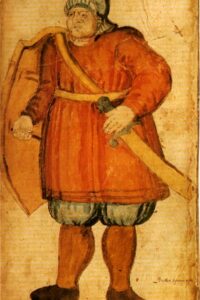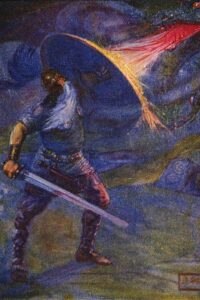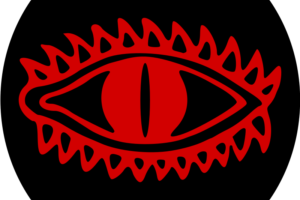Beowulf vs. Grettir: the 11th-century hero showdown you did need
We have all seen the Avengers, so we know who the strongest one is. But what about the heroes of old? What would happen if, let’s say, Beowulf, the great Geat warrior would have to fight against Grettir the Strong? What happens when Anglo-Saxon epic clashes against Icelandic sagas? Read to find out!
Now, before starting yet another date debate, let me tell you that Beowulf and Grettir did not live in the same time period. Beowulf was slaying dragons around the 6th century, while Grettir had not even been conceived by that time. Our Icelandic antihero lived through the 10 and 11th centuries, while his story is actually found in a 14th-century manuscript. So, what does the 11th century has to do with any of them? Grettir lived in the time the Beowulf manuscript was being redacted (or so some scholars believe at least, cf. Neidorf 2014), and this is probably the only thing that the two heroes have in common. Or is it?
Magnús Fjalldal lengthily explained how the two stories (i.e. Beowulf and Grettir’s Saga) have been compared endlessly by both Old English and Old Norse scholars. In particular, there are five episodes (the Sandhaugar Episode being one of them as possibly related to the Bear’s Son Tale, cf. Panzer 1910) that are considered to be “genetically” related, but Fjalldal shows us how the majority of the arguments in favour of this view are simply not substantial enough. Perhaps, the most interesting analogy would be between Grettir and Grendel, insofar they are both considered monsters (as explained below), and both end up beheaded (Fjalldal 1998).

However, as monstrous as he looks (Grettir is depicted having a troll-like appearance), Grettir the Strong is actually a hero. He is described in the saga as “the strongest man in the land” and “better able than any other to deal with spectres and goblins” (ch. 93), just as Beowulf was “the man who of all men was foremost and strongest in the days of this life” (lines 788-89) and who “battled and bound five beasts, raided a troll-nest and in the night-sea slaughtered sea-brutes” (lines 420-22). But if Beowulf had the “the strength of thirty in the grip of each hand” (lines 380-81), Grettir could never reach his full potential due to Glámr’s curse:
And yet, if the two had existed in the same universe, Grettir would have defeated Beowulf, and not because of his strength, but for the unspoken reason that makes him a hero and a monster at the same time.

But before we enter the multiverse, let me tell you a bit more about our two heroes. You all know Beowulf, the king of the Geats and slayer of dragons, the friendly neighbour who helps you disinfest your Hall from hellish fiends. He is your mythological hero, in the most Joseph Campbell sense of it. After all, not everyone gets a cameo in Tolkien’s novels, video games, computer-animated movies, and a rock opera. Possibly even queer (cf. Price 2020)? Grettir, on the other hand, has not enjoyed the great fame that comes from slaying monsters. And why so? Because he is a monster himself, or so the Icelanders of his time thought.
Grettir was a farmboy, who spent most of his childhood at his father’s house in Bjerg, Iceland. Eventually, due to a series of shenanigans (for a detailed, yet sarcastic, summary of them go to Gravepine) he becomes an outlaw, and not just once, but twice! The first time, during the 14th year of his life, he gets sentenced to three years in Norway. The second time, after accidentally burning some Norwegians to death, he gets “full outlawry”, hence forever banned from his community, but not before getting cursed upon (literally) by the revenant called Glámr (the very same character we encountered earlier, who condemns him to an incomplete growth). From that moment on, he is doomed to loneliness and bad luck, while growing increasingly afraid of the dark:

So here we are, on one side the hero, on the other the outlaw, both fighting monsters, both protecting their communities, both killing villains whose names start with Gs (coincidence? I think not!), both ana on orde (“alone in the front”, cf. Ziehe 2012), and yet, at the very end, one receives a grandiose funeral, while the other is ambushed and killed, unable to escape due to an amputated leg. Beowulf and Grettir share the heroic loneliness, but with very different implications and outcomes. Beowulf fights alone, but he can rely on a support system, whereas Grettir simply does not have one. Beowulf becomes a King, Grettir dies alone and a criminal.
At this point you may all think, is Grettir’s saga none other than a metaphor for the changing of times? Christianity has arrived (Iceland adopted it as a common religion in 1000 AD), there is no space for fairies and monsters anymore: has Grettir, as the last standing hero of old, the dreadful task of “cleansing” Iceland of its pagan symbols (Firth 2017)? Is Grettir an “old” character in a “modern” setting, hence the only one able to fight mythological creatures and die as one of them because he himself is one (Cardew 2017)? Very much so. And if that is the role of Grettir, then he would definitely put an end to our beloved Beowulf.
And yet, as anachronistic as Grettir might appear in his saga and in the time his story was told, he emerges as a much more realistic hero than Beowulf. A millennium later, and he is closer to us than the medieval Captain America will ever be. Grettir is Wolverine without a redemption arc, Quasimodo without a happy ending. But, perhaps, it matters not if they are similar or different, relatable or surreal, and perhaps, trying to find a connection between the two would not make the saga or the epic better or worse. Sometimes the heroes and antiheroes exist in the same world, and we can simply admire them both and sympathize with their desire to be accepted just for who they are.
Further Reading:
Cardew, Philip. 2017. “What manner of man is this? Representations of monstrosity, identity and world view in early medieval narrative”. Palgrave Communications 3: 17012. https://doi.org/10.1057/palcomms.2017.12.
Firth, Matthew. 2017. “Monsters and the Monstrous in the Sagas – The Saga of Grettir the Strong”. The Postgrad Chronicles. https://thepostgradchronicles.org/2017/10/29/monsters-and-the-monstrous-in-the-sagas-the-saga-of-grettir-the-strong/.
Fjalldal, Magnús. 1998. The Long Arm of Coincidence: The Frustrated Connection between Beowulf and Grettis saga. Toronto: University of Toronto Press.
Heaney, Seamus, trans. 1999. Beowulf. London: Faber and Faber.
Hight, G.H. trans. 1914. Grettir’s Saga, Icelandic Saga Database, edited by Sveinbjorn Thordarson. http://www.sagadb.org/grettis_saga.en2.
Neidorf, Leonard, ed. 2014. The Dating of Beowulf: A Reassessment. Boydell & Brewer.
Price, B.A. 2020. “Potentiality and Possibility: An Overview of Beowulf and Queer Theory.” Neophilologus 104: 401–419. https://doi.org/10.1007/s11061-020-09636-8.
Ziehe, Mary E. 2012. “Alone in the Front”: Isolation and Community in the Hero’s Life in Beowulf. Master Thesis.
© Martina Marzullo and Leiden Arts in Society Blog, 2022. Unauthorised use and/or duplication of this material without express and written permission from this site’s author and/or owner is strictly prohibited. Excerpts and links may be used, provided that full and clear credit is given to Martina Marzullo and Leiden Arts in Society Blog with appropriate and specific direction to the original content.



0 Comments